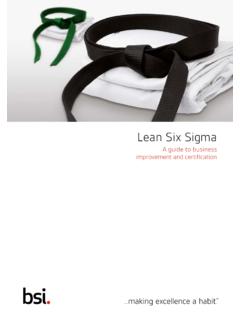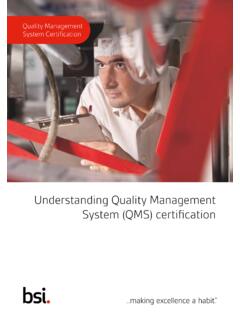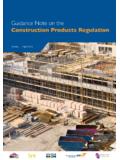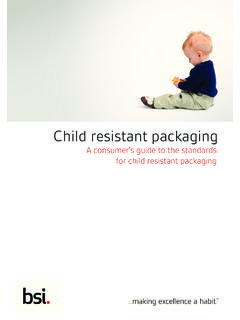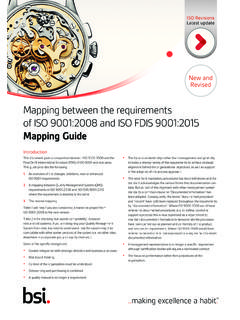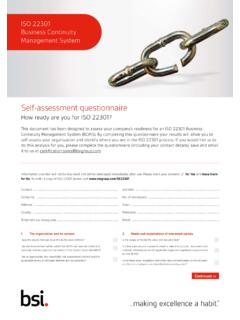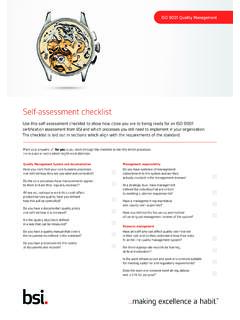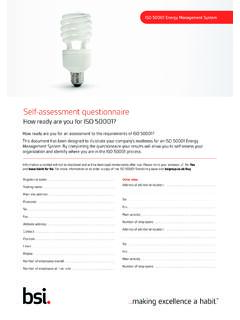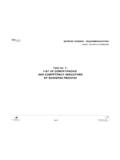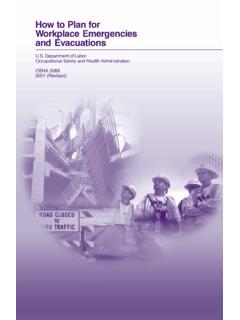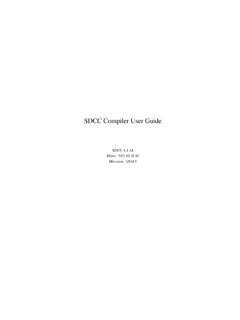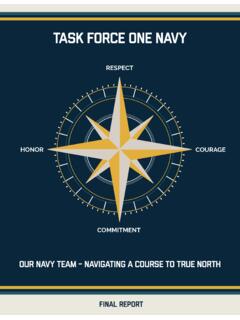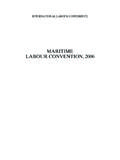Transcription of Technical Documentation and Medical Device Regulation
1 Technical Documentation and Medical Device RegulationA Guide for Manufacturers to Ensure Technical Documentation Complies with EU Medical Device Regulation 2017/745Dr Julianne Bobela, Project Associate; Dr Benjamin Frisch, Senior Associate; Kim Rochat, Senior Partner; and Michael Maier, Senior Partner; all at Medidee Services SAiiTechnical Documentation and Medical Device RegulationContentsIntroduction 1 Transition to the new legislation 1 compiling the Technical Documentation 2 Content of the Technical Documentation 4 Other Technical Documentation requirements 5 Post-market surveillance plan 6 Conformity assessment review of Technical Documentation 7 Person responsible for regulatory compliance 8 Requirements related to authorized representatives 8 Archiving periods for Technical Documentation 8 Summary from the MDD/AIMDD to the MDR: what changes with regard to Technical Documentation ?
2 8 Contributors 10 Authors 10 Expert Reviewers 10 Advisory Panel 11 Published white papers 11 Forthcoming white papers 12 About BSI Group placing a Medical Device on the European market, manufacturers need to produce Technical Documentation providing evidence of conformity with the relevant legislation. Technical Documentation needs to be in compliance with the Medical devices Directive (MDD) 93/42/EEC or the Active Implantable Medical devices Directive (AIMDD) 90/385/EEC (referred to as MDD/AIMDD hereafter).On 26 May 2017, a new Regulation entered into force, meaning that by 26 May 2020, for manufacturers to obtain or renew a CE certificate or to issue a Declaration of Conformity (DoC), their Technical Documentation will need to comply with the Medical Device Regulation (MDR) European Union (EU) Regulation 2017/745 (referred to as MDR hereafter).
3 However, as indicated in Article 120 of the MDR, after 26 May 2020, Medical devices can still be placed on the market under the provision of the MDD/AIMDD, providing the certificate was issued prior to this date, that manufacturer continues to comply with either one of the Directives and that no significant changes are made in the design and intended purpose of the Device . Manufacturers of such devices must also meet other requirements, which are detailed in Article 120 of the MDR and referenced later in this white paper. The certificates issued in accordance with MDD/AIMDD after 25 May 2017 remain valid until reaching their expiry date, but in any case, they become void latest on 27 May necessitates changes for the manufacturers, Competent Authorities (CAs) and Notified Bodies (NBs) on how the Technical Documentation should be developed and handled. As mentioned in the first paragraph from Annex II of the MDR, the Technical Documentation and, if applicable, the summary thereof to be drawn up by the manufacturer shall be presented in a clear, organised, readily searchable and unambiguous manner and shall include in particular the elements listed in this Annex.
4 Reading the MDR it becomes evident that the requirements for Technical Documentation have been raised and will also be subject to more scrutiny by the CA/NB as appropriate. This white paper gives manufacturers an interpretation on how the changes necessary for the move from compliance with the MDD/AIMDD to the MDR might be implemented, as well as practical hints on what needs to be considered in order to maintain Technical Documentation as stipulated by the to Article 10 of the MDR Technical Documentation shall be such as to allow the conformity of the Device with the requirements of this Regulation to be assessed . The preparation of Technical Documentation , required for all classes of Medical devices , is the manufacturer s responsibility, as is the provision of access to these documents upon request by the CA or NB. Since Technical Documentation is often extensive, sections of it may be stored in different locations, which are usually controlled by the manufacturer s quality management system.
5 Furthermore, Technical Documentation must be updated promptly and as necessary during the lifetime of the Device , to ensure it accurately reflects the current status, specification and configuration of the subset of the information contained in the Technical Documentation is used by the manufacturer, when submitting the Device to the NB for pre-market or post-market conformity assessment activities. With the aim of globally standardizing Medical Device regulatory submissions, the Global Harmonization Task Force (GHTF) has created the Summary Technical Documentation (STED) , intended to be a consistent, summarized or abridged form of the Technical Documentation , with sufficient detail to allow the NB to fulfil its obligations. The STED represents the status of the Medical Device at a specific moment of its life cycle and should be updated to correspond to the Technical a follow-up initiative, the International Medical devices Regulators Forum (IMDRF) published a guidance document, providing an internationally harmonized format, in the form of a Table of Contents,1 that could be used in the future for the electronic submission of Medical devices to a reviewing body for market to the new legislationThe MDR requires existing ( legacy ) Medical devices to undergo conformity assessment to the MDR and to be CE marked anew, even if they have been on the market previously under the MDD/AIMDD (no grandfathering ).
6 These devices will need to have their compliance with the MDR assessed by a NB, otherwise, manufacturers will no longer be able to declare conformity with the applicable Regulation , and may, as a consequence, lose their CE marking at 1 IMDRF/RPS WG/N9 FINAL:20142 Technical Documentation and Medical Device Regulationlatest in 2024. Manufacturers of class I devices , which are not provided sterile, have no measurement function and are not reusable surgical instruments, will also need to update their Technical Documentation in order to comply with the Regulation , even though they may issue a MDR compliant DoC without involvement of a NB. This necessitates work from manufacturers to adopt the requirements of the MDR with regard to Technical Documentation , should they wish to keep their devices on the European market or introduce new devices . It also implies that manufacturers of devices , even those that have been on the market for many years, need to start collecting or complete review of existing Post-Market Surveillance (PMS) data, to be able to cover the requirements related to clinical evaluation, as set out by Article 61 of the MDR.
7 Manufacturers need to implement all MDR PMS requirements with effect from 26 May 2020, even if the devices concerned are still being placed on the market under the MDD/AIMDD. Indeed, in Article of the MDR it is clearly stipulated, that for manufacturers of devices with a certificate that was issued in accordance with the MDD/AIMDD, the requirements of this Regulation relating to post-market surveillance, market surveillance, vigilance, registration of economic operators and of devices shall apply in place of the corresponding requirements in the the Technical documentationTechnical Documentation has to be developed during the design and development process of a Device and maintained throughout its entire life cycle. As illustrated in Figure 1, this process can be represented using the V-model, as it delivers documents and records, which form the Design History File (DHF).Design reviews that approve or reject design inputs as well as ongoing results of the design and development process verify the status of documented results at certain points in the process.
8 It is important to ensure that the requirements and solutions, which are adopted during a review for Device improvement, are documented in the Technical Documentation (DHF, Device Master Record (DMR) and STED). The design Verification and Validation (V&V) of individual components, subassemblies, assemblies and the entire Device provide the evidence of whether Figure 1 V-model of the design and development processMarketPRODUCTVAVEVE 1VE 2F/C 2F/C 1 FRSURSD esigninputsDesignReviewsDesignReviewsDes ign &DevelopmentPlanTechnicalDocumentationST ED / TechnicalDocumentationaccording to Annexes IIand IIIP roduct itselfManufacturing ProcessesDocumentsKey:URS: User : Functional : Feature / ComponentVE: VerificationVA: have been met. If they have not, changes may need to be made to the specifications, by applying the design change control procedures of the implemented quality management system.
9 The design outputs, which are based on these changed specifications, undergo the same verifications, validations and finally design reviews. These are the basic principles of a design and development process and of a Device V& Technical Documentation represents the entirety of the documents describing a Device . It therefore includes the Device s design, development, V&V (including clinical and performance validation) as well as its regulatory status within target markets. Furthermore, the MDR now requires a closed loop process, implemented with data from the post-market use of the Device (PMS), in order to ensure that early warnings are captured, that the General Safety and Performance Requirements (GSPRs) 2 are continuously fulfilled and that the benefits for the patient always outweigh the Technical Documentation should be structured and presented, in such a way, as to facilitate its review and assessment by the NB (Figure 2).
10 This means that the compilation of Technical Documentation requires the application of quantitative and qualitative filters, allowing an adequate level of detail to be maintained, while avoiding the inclusion of superfluous details not necessary to demonstrate fulfilment of the illustrated in Figure 2, specific elements required by the NB for the review ( cover letters etc.), as well as the elements from the Quality System (QS) required to demonstrate compliance, are also to be included in the Technical Documentation . Post-market data is the final subset of documents to be included; for new devices this may consist of, amongst other things, vigilance data from competitors and of the manufacturer s plan for activities to be implemented once the Device is on the market (such as a Post-Market Clinical Follow-up (PMCF) Study); for devices that have previously been placed on the market, this includes, but is not limited to the PMCF data, vigilance data, user feedback and complaints.
